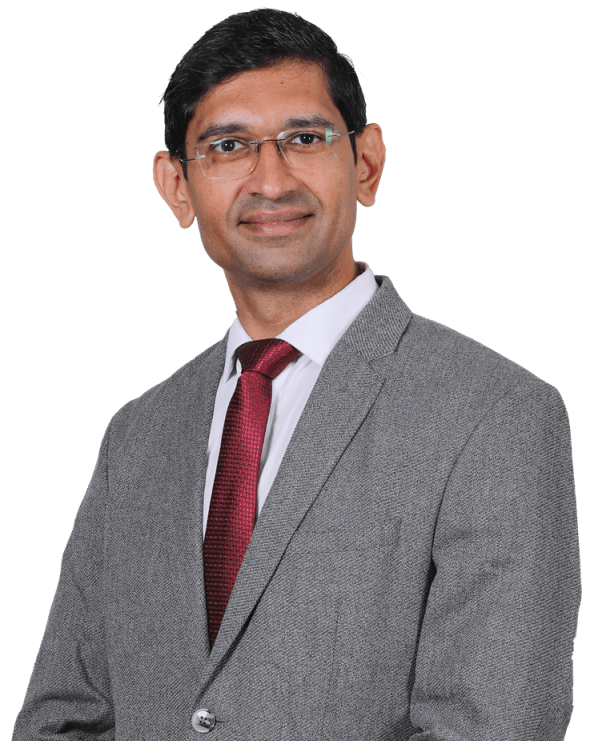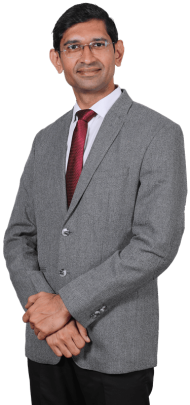Meet Our Expert Dr. Siddharth M. Sakhiya
An artisan of cosmetic mastery, brings out the best in your unique beauty.

In FUT hair transplant surgery, an appropriately sized strip of skin containing hairs with intact roots is harvested from back and side of the head and resulting area is closed carefully by meticulous Plastic surgery suturing under magnification to give least conspicuous scar in this area. Individual grafts (follicular units) are being separated from this strip of skin under magnification and implanted in the same way as FUE inside micro slits.We use Carl Zeiss 4x magnification loupes in harvesting skin strip to avoid damage to follicles at the donor site and to make suturing meticulous.Another important thing to give the best result is to reduce ischemia time (time during which hair roots remain outside body-before implantation). We make micro-slits on recipient area before harvesting strip, which increase survival of hair more than any other technique.
In a single session, we can harvest a larger number of follicles, thanks to reduced transection rates during the harvesting process. This is achieved with the assistance of a team of trained technicians who meticulously separate the follicles under magnified vision. We can transplant up to 3500 follicles in one session, ensuring maximum hair density on your head.
Furthermore, a greater number of hairs typically grow from the transplanted follicles due to significantly lower transaction rates compared to FUE.
It’s important to note that all transplanted hairs are sourced from the “safe permanent zone” of your scalp, ensuring their longevity on your head for many years.
While the FUT technique may leave a scar at the back of your head, it’s important to note that this scar may become visible if you prefer to maintain a completely shaved hairstyle or a very short 1-2 mm hair trim at the back.
Regarding the perception of pain associated with FUT, we encourage you to seek reviews from our FUT transplant surgery patients. They can attest to our efforts in making the procedure as painless as possible.
The Follicular Unit Transplantation (FUT) technique is a surgical procedure used for hair transplantation. While it is generally considered safe and effective, like any medical procedure, there are potential risks and complications associated with FUT. It’s essential to discuss these risks with your surgeon before undergoing the procedure. Some of the risks associated with FUT include:
Scarring: FUT involves the removal of a strip of scalp from the donor area, which can result in a linear scar at the donor site. While skilled surgeons aim to minimize scarring, there is a risk that the scar may be wider or more noticeable in some individuals.
Pain and Discomfort: After the procedure, patients may experience pain, discomfort, and swelling at both the donor and recipient sites. This is usually temporary but can vary in intensity among individuals.
Infection: As with any surgical procedure, there is a risk of infection. Surgeons take precautions to minimize this risk, such as using sterile techniques and prescribing antibiotics as needed.
Bleeding: Some bleeding is normal during and after the procedure. However, excessive bleeding can occur, and it’s essential to monitor and manage it promptly.
Numbness: Temporary numbness or loss of sensation in the donor and recipient areas is possible due to nerve damage during surgery. This typically resolves over time, but in rare cases, it may be permanent.
Swelling: Swelling of the forehead and around the eyes can occur after the surgery. This usually subsides within a few days but may last longer in some cases.
Shock Loss: Temporary hair loss, known as shock loss, can occur in the donor and recipient areas after the procedure. This typically resolves within a few months as new hair growth begins.
Unnatural Hair Growth: In some cases, the transplanted hair may grow in an unnatural direction or pattern. Skilled surgeons aim to avoid this by careful planning and precise placement of grafts.
After your hair transplantation procedure, our priority is your comfort and recovery. We will provide you with pain relief medication and antibiotics to prevent infections. Our experienced surgeons are available for any questions or concerns you may have during your recovery.
To ensure the success of your transplant, please follow these guidelines:
Medication: Take the prescribed medications as directed to manage pain and prevent infections.
Hair Care: Be gentle with the newly transplanted hairs. Avoid any friction or shearing in the treated area. We’ll provide you with a protective cap to shield your head from dust.
Resuming Activities: You can resume your regular activities, including office work, the day after the procedure. However, it’s essential to avoid strenuous activities, prolonged sun exposure, and exercise for the next 15 days.
Hair Washing: You can start washing your hair 2 days after the procedure, following our instructions.
Hair Nourishment: Begin applying hair nourishing solutions as advised by our hair transplant surgeon.
Hair Shedding: Expect the transplanted hairs in the recipient area to fall off gradually over the next couple of weeks. The roots, placed under the skin, will remain. New hair growth from these roots typically starts after 3-4 months. Initially, the hair may appear sparse, but this is normal. Hair density increases gradually, reaching its maximum around 10-12 months post-transplant.
Long-Term Growth: Rest assured that the transplanted hairs will grow naturally throughout your life, behaving as they did in their original donor site.
Your journey to fuller, natural-looking hair is underway. Follow these guidelines, and don’t be concerned about hair density in the early stages. With time and patience, your newly transplanted hair will flourish, giving you the results you desire.
At Celebre Aesthetics, we are committed to providing you with exceptional care and results. Our experienced team uses the latest techniques to deliver natural, lasting hair restoration that boosts your confidence. Whether you’re considering a hair transplant in Surat, seeking expert care for a hair transplant in Ahmedabad, or exploring advanced solutions for a hair transplant in Rajkot, we have the expertise to help. For those looking at options across the country, our clinic also provides comprehensive hair transplant solutions in India to ensure you receive the best treatment. Book your consultation today and begin your journey to a fuller, more youthful appearance with Celebre Aesthetics!
Many people face a lot of hair loss issues due to multiple reasons like ageing, hormonal imbalances, genetic issues, etc.
Laser Hair Removal is a highly effective and efficient approach for the removal of unwanted body hair across various areas.
An artisan of cosmetic mastery, brings out the best in your unique beauty.

An artisan of cosmetic mastery, brings out the best in your unique beauty.

